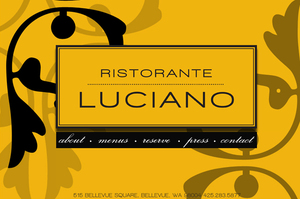 It was mid-morning on a Tuesday, and Luciano Bardinelli had just lit his first cigar of the day, On Sunday, Mother's Day, he'd served a full house; on Monday, he'd packed up his files and belongings. After a lifetime as an owner, headwaiter, manager, occasional line cook, waiter, busboy, Luciano was not going to work in one of his own restaurants. "My first day as a free man."
It was mid-morning on a Tuesday, and Luciano Bardinelli had just lit his first cigar of the day, On Sunday, Mother's Day, he'd served a full house; on Monday, he'd packed up his files and belongings. After a lifetime as an owner, headwaiter, manager, occasional line cook, waiter, busboy, Luciano was not going to work in one of his own restaurants. "My first day as a free man."
Luciano (no one calls him Signor Bardinelli for long) had come to Seattle exactly 30 years ago, in 1982. There was no Tom Douglas, no Ethan Stowell. There were no websites to chronicle the comings and goings of platoons of energetic young chefs, no Eater.com, no Voracious, no ChowHound.
Born on the shores of Lago Maggiore, in the northern Italian Alps, Luciano had already managed exclusive restaurants and private clubs in Las Vegas and the Hollywood Hills. One fine autumn day in 1981 he happened to pay a call on a friend in Seattle, and found that the landscape of red and yellow leaves reminded him of home. Within months, he had left the desert and driven to Seattle, the radio of his U-Haul tuned to the Kentucky Derby. ("The winner was a long shot named Gato del Sol," he recalls.)
Luciano became the Godfather to Seattle's Italian restaurant renaissance. He was not a chef by training or temperament; his strong suit was Armani (topped these days by a full head of white hair), served with an urbane elegance. French was the cuisine of prestige back then, but Settebello, his first Seattle restaurant, on Capitol Hill was decidedly Italian. Not low-brow, Spaghetti House meatballs-in-red-sauce but classy, suave northern Italian: osso buco, agnolotti stuffed with veal, tiramisu. In the course of its ten-year run, it changed the way Seattle thought about food--not just Italian food, but restaurant food in general.
One of his cooks was Scott Carsberg, who'd fallen in love with Italian food, and went on to start Lampreia and Bisato; he's the exception: a chef who really knows and understands Italian cooking. A mutual friend says, "Luciano has a point when he says that these Americans go to Italy for three months and think they know how to make pasta and cook Italian food. The soba masters in Japan study the art of making noodles for 15 years, and then spend the next 30 perfecting it. You can't just order it frozen from California." In an interview for the Seattle Times five years ago, Carsberg returned the compliment: "Luciano was the best front man in the Italian genre. He brought modern Italian cuisine to Seattle."
Vancouver, BC, had a similarly gregarious Italian promoter named Umberto Menghi, who'd started building a restaurant empire ten years earlier. Word got around, and pretty soon Umberto sent down his associate, Carmine Smeraldo, to open an outpost in Pioneer Square. Umberto withdrew within a couple of years but Carmine remained; he and Luciano became best friends.
"Carmine and I were the same age. We were like brothers," Luciano told me this week. "After he died in January, I thought, it's time to scale down and do something else."
What he'd been doing for three decades, of course, was opening and running restaurants. A string of them after Settebello: Stresa, Sans Souci, Italianissimo, among others. Sometimes he'd become a minority partner and help out a friend; sometimes he'd make bad bets on a location or a concept; sometimes he'd become distracted by marital problems. His last place, Ristorante Luciano, had a great location, Bellevue Square; a landlord, Kemper Freeman, with a reputation for being hard-nosed; and a clientele of Yelpers quick to complain about high prices and a mis-fired dish.
"I owed a lot of money, but Mr. Freeman released me. And he gave me a going-away party. He paid for 60-70 people." In attendance: Eastsiders who'd been coming to the restaurant regularly, along with a few Seattle diners who'd remained loyal.
At Bellevue Square, a new tenant is already lined up: Spice Route Cuisine, a mid-market Indian restaurant, currently at Crossroads. As for Luciano, after taking some time off for a trip back to Italy, he'll resettle in Morro Bay, Calif., where he has his eye on a little house overlooking the Pacific. "Twenty seats, retired people who come in two-three times a week. I'll go to the market for produce and fish and fix a fresh menu every day." He hopes to be open by mid-summer.
Leave a comment